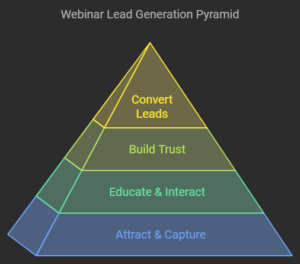
Actually, lead generation is one of the bases for business growth as it involves the strategy to attract and capture the interest of potential customers, and then engage the prospect into conversion. It goes a long way towards establishing a quality pipeline, with a surety to guarantee sales opportunities arriving at a steady pace. Among these, webinars have emerged as particularly valuable tools for producing high-quality leads, combining education and interactivity. Businesses can position themselves as authorities while quickly addressing the pain points of their audiences in real-time.
Webinars will create a unique experience, and improve trust and authority in the market. A new report, based on some recent statistics, shows that 73% of marketers believe webinars are highly effective for lead generation, and 20-40% of attendees become qualified leads. Moreover, 91% of webinar attendees report finding them interesting. These statistics have shown that webinars are unique in the means of information sharing through live interaction.
What Makes Webinars Effective for Lead Generation?
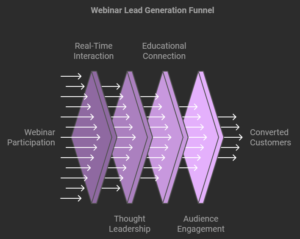
Webinars are good for generating leads because they are very interactive and engaging. Unlike static content formats, webinars afford a chance for real-time interaction through Q&A sessions, audience polls, and direct exchanges between speakers and participants. Such two-way communication makes for a strong sense of engagement and keeps the audience active throughout the session.
Businesses sharing expertise and addressing pain points make them known as thought leaders in their field. Because these webinars encourage an educational, interactive, and personal connection between business and customer, webinars are a valuable attraction, nurturing, and conversion tool for devoted customers.
Types of Webinars Ideal for Lead Generation
There exist different types of webinars, all targeting lead generation with unique values for the audiences. Educational webinars are a popular style; their focus is on in-depth knowledge delivery across topics relevant to the target audience. They establish the host as an expert while facing various questions and problems from the attendees.
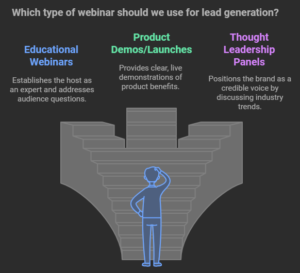
Effective in showing how the product or service works, product demos or launches provide interested prospects with clear and live notions of its benefits and features.
Thought leadership panels, too, are a great opportunity in that they invite industry experts to discuss trends innovations, or challenges and therefore position your hosting brand as a credible voice in the space.
Case study presentations highlight real case histories and demonstrate how a product or service solves specific problems. The format provides proof of the value that can be generated, which helps in building trust and driving conversions.
Either of these can attract audiences in the most effective way of driving the very best quality leads.
Planning a Successful Webinar for Lead Generation
Massive planning underlies a successful webinar: starting from identifying and knowing the target audience. With demographics, interests, and pain points in mind, you will get content tailored with them in mind. A clear outline of your audience ensures that you attract participants who are genuinely interested in your offerings and have a high probability of converting leads.

Then, a pertinent and interesting topic is very important. Your topic needs to speak for a problem it solves, its actionable solutions, or deliverable insights. It not only gets eyes but also endorses your brand as an authority in your area of specialization. Most topics typically involve the latest trend in an industry, a hands-on demonstration, or the advice of an expert.
Another important factor is the choice of webinar platform. A readily available, interactive environment with features such as voting or Q&A, as well as reliability, are all important factors in creating an experience with minimal disruption for viewers. Some platforms that can be used for this type of session include Zoom, Webex, or GoToWebinar.
Now, there are clear objectives. Whether it’s raising awareness about your brand, fostering leads, or actually selling, your goals should be what drive every component of your webinar strategy. When correctly planned, webinars can be a very effective lead-generation practice.
Promoting Your Webinar to Maximize Attendance
Needless to say, promoting effectively is necessary to maximize attendance. Reach potential leads through email marketing. Design attention-grabbing, personalized emails that clearly spell out the value of attending your webinar. Include key takeaways, include a direct registration link, and remind them about the date as it approaches.
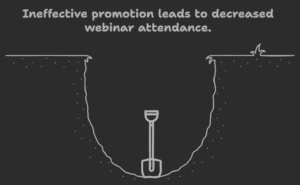
Leverage the power of social media to reach new people. Share visually attractive posts across multiple channels, such as LinkedIn and Twitter that the webinar addresses specific problems. Use targeted ads to attract new people and include relevant hashtags to improve discoverability. Posting short teaser videos or speaker highlights can build excitement, too.
Partnering with influencers and industry leaders will certainly enhance your credibility and encourage their followers to attend your event. Therefore, ask them to advertise your webinar in their social networks, which becomes a win-win situation for both parties.Co-promotion increases visibility and more trust in the worth of your webinar.
Lastly, an appealing landing page should be created for registration to the webinar. Here, one needs to include a catchy headline about the event, the description of the event, speakers’ details, and clearly visible call-to-action (CTA). Testimonials or highlights of previous webinars may be used to bring in credibility. A user-friendly page can be the difference between huge registrations and attendance rates.
Engaging Your Audience During the Webinar
Keeping the interest of your audience through a webinar is the best way you can do in creating the experience and trusting them. The best strategy for this includes using polls and surveys around the session. For one, polling and surveying allow you to gain insights about your audience, ensure active participation, and keep attendees actively engaged. For example, conduct a poll to determine how well the participants are familiar with the topic and use your feedback to tailor your presentation in real-time.
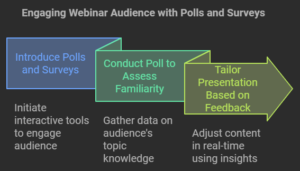
Engage the audience well through Q&A sessions that allow them to participate and answer questions raised. You can schedule a block of time for questions before or after your presentation. This will allow them to feel respected and heard as you also have the opportunity to address a few questions or elaborate on a couple of relevant points. You may use real-time chat or provide a specific Q&A section for easier interactions.
Most importantly, provides information that will give valuable insights and takeaways. Provide material that solves real problems or equips your audience to adopt practical strategies or implement strategies immediately. Steer clear of flooding the audience with details and instead seek to communicate clear and precise points with examples or case studies. A webinar that leaves attendees feeling valued and empowered creates trust and makes your brand synonymous with the latest information in your industry.
Post-Webinar Strategies for Lead Nurturing
Follow-up after the webinar will be quite important to nudge those leads into becoming customers. Keep in mind that a follow-up email with the recording of the webinar and other resources like the slides, handouts, or even valuable posts on your blog will help attendees revisit all that has been said in the webinar and further help them realize the value provided by your own webinar. Thank them for their participation and leave a long-lasting positive impression.
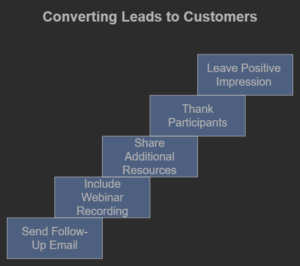
Another more important strategy is to segment leads based on their engagement during the webinar. Identify those who asked questions, who interacted with polls, or stayed till the end, for they might be the ones who are really interested and further along in the buyer’s journey. Tailor your follow-up communication to match this level of engagement-at times the higher interacting might benefit from personalized consultation/demonstration, whereas the least interacting would get general information to open up the conversation more.
Finally, use your follow-up email to share a strong call-to-action (CTA). Provide incentives such as a free trial, consultation, or even a detailed guide based on the topic. A clear CTA nudges recipients to take that next step and keeps the momentum going after the webinar. Combining these strategies will help you nurture effective leads and create further conversions.
Conclusion
Webinars have been a very worthwhile source of lead generation. They provide the opportunity to interact in real time with prospective customers, hence enabling engagement. From presentations, Q&A sessions, and even active features such as polls, webinars empower businesses to establish credibility and connect well with their target audience. Other marketing formats will not engage as much as webinars will because the information gained and the actionable outcome for attendees is profoundly impressive. Consequently, they significantly enhance brand exposure and create quality leads.
It’s truly smart to incorporate webinars into your overall marketing strategy. They complement all other digital marketing efforts, ranging from content marketing to social media campaigns and email outreach. They allow the education and information of leads, which helps move those leads through a sales funnel. Done right, with proper planning, promotion, and execution, webinars can do far more than just cement your brand authority; they can actually lead directly to conversions.
